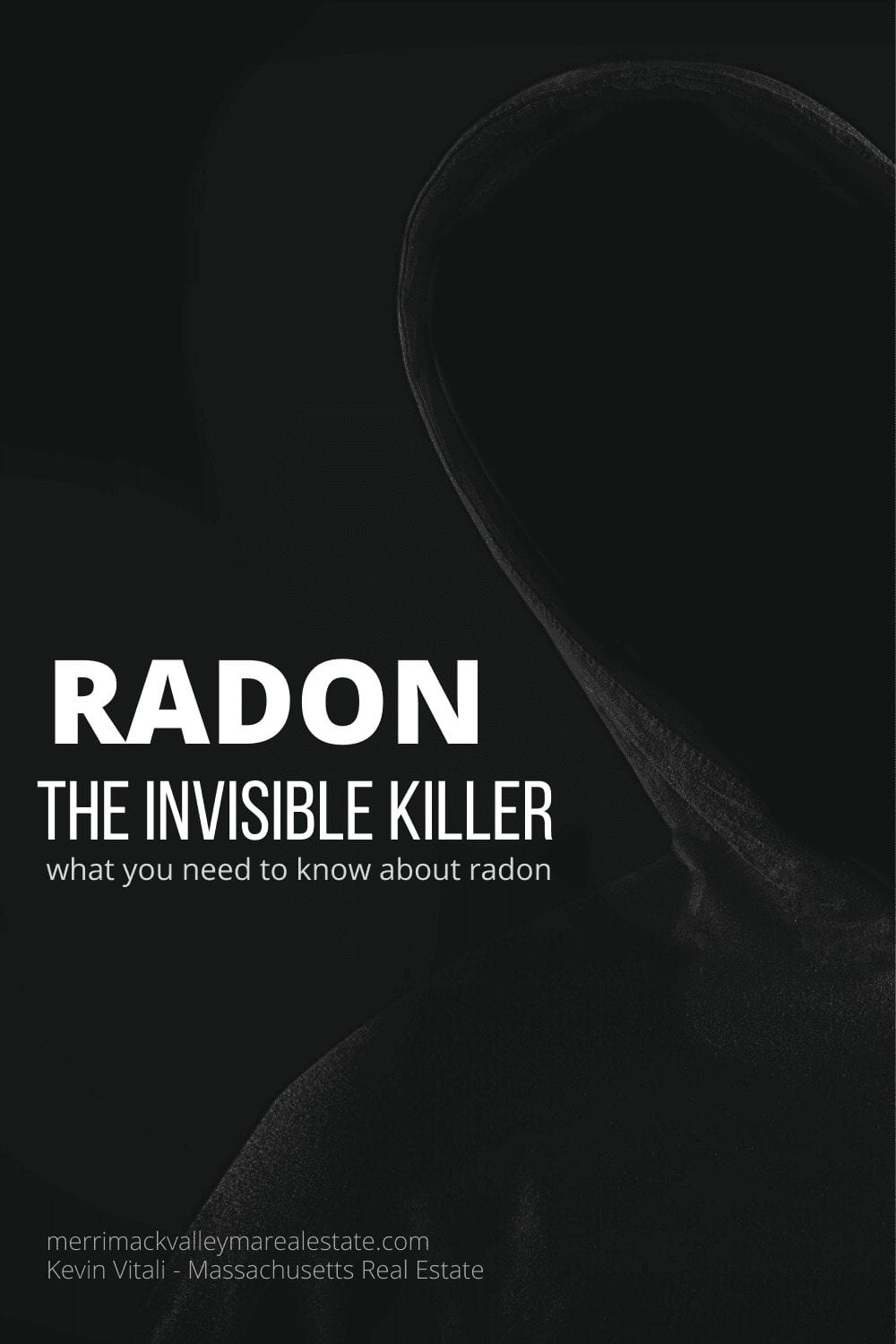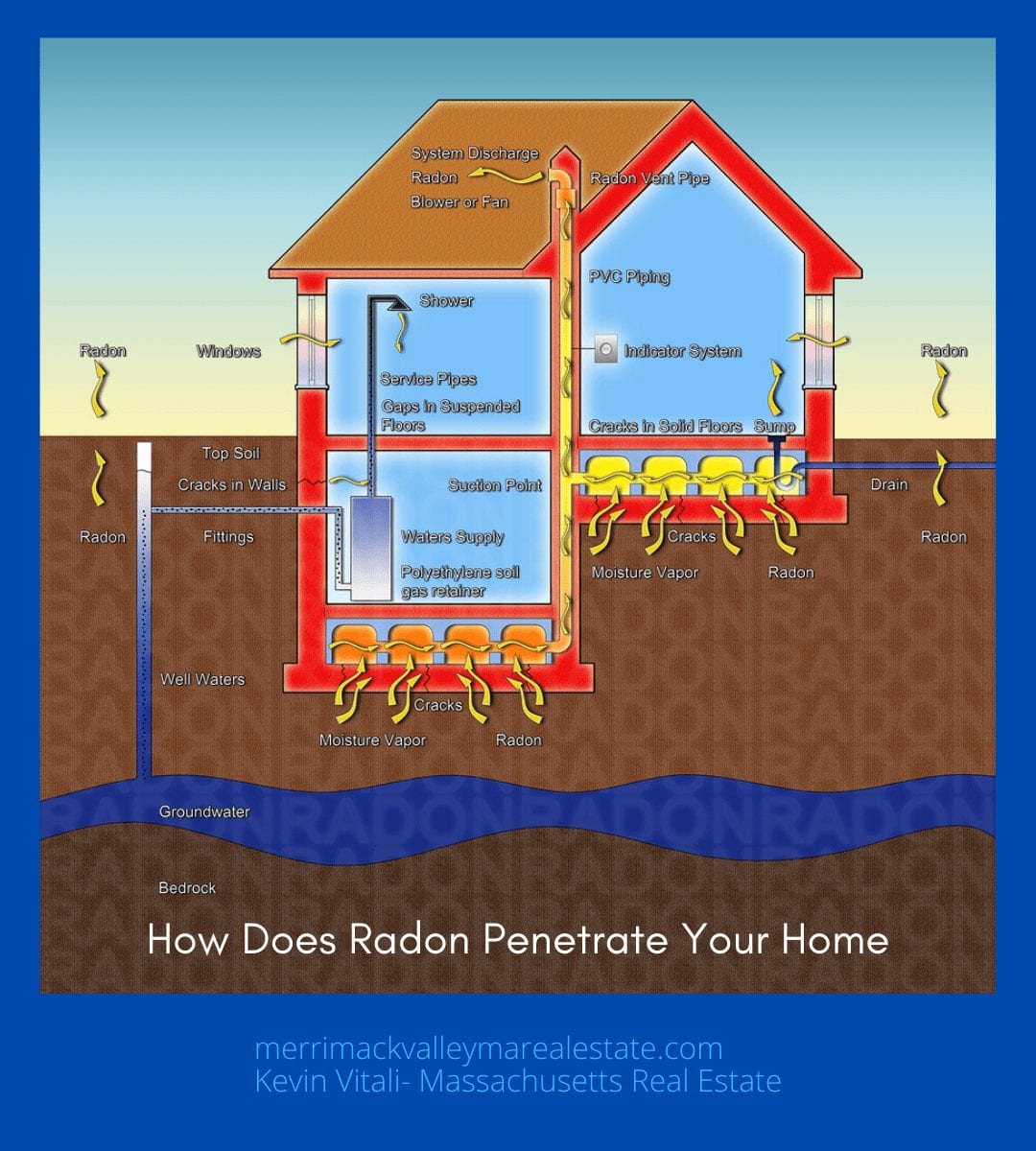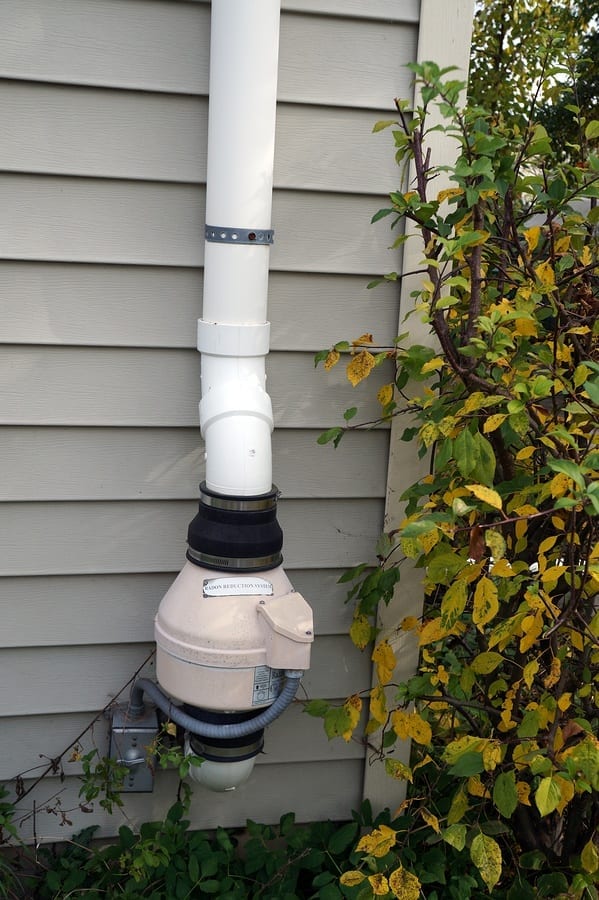

Radon, an invisible and odorless radioactive gas, poses significant health risks if left undetected.
Let’s look at radon gas in the home, how it gets into your home, the dangers, causes, testing methods, available remediation options and the importance of addressing radon in a home to protect your family’s well-being.
Understanding this silent threat more deeply, you can proactively safeguard your loved ones and create a healthier living environment. Take the time when you purchase a home to test for radon in the home you are about to purchase.
What is Radon Gas?
Radon gas is a naturally occurring, radioactive gas that is unable to be detected without conducting specific tests.
It forms due to the natural breakdown of uranium and other elements in rocks and soil. As radon is emitted from the ground, it seeps into the air, infiltrating homes through basement floors, walls, and even well water in properties relying on private wells.
Due to its colorless and odorless nature, radon can go unnoticed for extended periods without regular testing, making it particularly dangerous. Testing should happen every couple of years to prevent excessive radon gas in the home.
The Dangers of Radon Gas
Radon gas is a known carcinogen and the second leading cause of lung cancer in the United States. Prolonged exposure to high radon levels significantly increases the risk of developing lung cancer.
Unfortunately, its undetectable nature allows it to accumulate silently in homes, especially in newer, more airtight constructions, trapping the gas inside.
Radon is omnipresent, even found in trace amounts outdoors and emitted by everyday items like granite countertops. However, outside, it quickly disperses, posing minimal risks.
Radon Gas In The Home: Where To Find It
While radon is present in varying concentrations throughout a home, the highest levels are typically detected in the basement, gradually decreasing on higher floors.
As the gas emanates from the ground, basements become home entry points.
Consequently, testing the basement for radon levels becomes crucial, as it is a reliable indicator of the overall radon concentration within the property.
The Problem of Radon In The Home
As we pointed out, radon gas is completely undetectable by the human senses. A home traps the dangerous gas inside and the radon can accumulate to dangerous levels.
And where do we spend a significant amount of time? In our homes.
And, typically lower levels of our homes have higher levels of the home, meaning your basement family room or man cave remodel can be particularly prone to high radon levels. But that simple test can help protect your family.


Testing for Radon Gas In The Home
Several testing methods are available for detecting radon gas to ensure your home’s safety.
During the home purchasing process, a short-term test is often conducted to obtain results promptly. This test typically involves placing two canisters with activated charcoal, which absorbs radon gas, in the lowest level of the home, usually the basement.
After 48 to 96 hours, the canisters are sealed and sent to a testing laboratory. Within a day or two, you will receive the results via email.
Typically, your home inspector will have radon test kits to place for you or your buyer’s agent to pick up later.
Alternatively, continuous radon monitors are popular due to their precision and convenience. These monitors chart radon levels over 2 to 3 days, providing nearly immediate results.
They offer a comprehensive overview of radon fluctuations, showcasing peaks, valleys, and average concentrations. Homeowners can also purchase radon detectors for ongoing monitoring of radon gas levels in their homes, providing short- and long-term results.
Where Can I Buy A Radon Gas Test Kit?
In northeastern Massachusetts, you can buy radon test kits and drop off for results at AccuStar Labs in Haverhill or New England Radon in Salem, NH. Test kits can also be purchased at big box stores like Home Depot and Lowes and mailed to a testing center.
Results may take up to 4-7 days from placing the radon test kits. Make sure you plan your test in accordance with your home inspection contingency in your contract so your radon test is completed by your contingency date.
Cost and Interpretation of Radon Test Results
Testing for radon gas is relatively affordable, with test kits and associated services ranging from $40 to $100, depending on the method used and whether you perform the testing yourself or hire a professional.
Continuous radon monitors typically cost between $200 and $250 but offer the advantage of quick results.
It is important to remember that radon is omnipresent, and low levels of radon are commonly found in homes and even outdoors. The Environmental Protection Agency (EPA) recommends taking action for levels equal to or exceeding 4 pCi/L (pico Curies per Liter), considering remediation for levels between 2 and 4 pCi/L.
However, remember that radon concentrations fluctuate throughout the year, potentially reaching higher levels during certain seasons. Consult with a radon professional to evaluate the best course of action based on your circumstances.
Radon Gas In The Home: How To Remediate
The good news is that home radon remediation is relatively simple and inexpensive. The most common method used is sub-slab depressurization, which involves installing a conduit into the concrete slab at the lowest point of the house.
This conduit redirects the radon gas outside and above the roofline using a low-pressure fan, creating a vacuum beneath the slab and effectively removing the gas from the home. Professional radon remediation contractors often guarantee results below 4 pCi/L, ensuring a safer living environment.
Before installation, the contractor will seal visible cracks and voids, including any necessary modifications to sump pump covers if applicable.
Usually, only one suction point is needed, simplifying the process. While some buyers may request levels below 2 pCi/L, it is important to note that contractors cannot guarantee this.


Testing Well Water for Radon Gas
In addition to testing the home for radon gas, it is equally important to test well water, especially for homes utilizing private wells.
Water from wells absorbs radon as it percolates through bedrock and soil, potentially resulting in elevated radon levels. It is crucial not to assume that low levels detected in the living space translate to safe levels in the well water.
It is also advisable to test the well water in the home for radon gas. Remember a well is deeper than the basement and could pick up dangerous levels of radon 100s of feet below the surface.
Removing Radon from Well Water
Eliminating radon from well water requires specialized systems such as aeration or granulated carbon. An aeration system introduces air into a sealed tank, releasing radon from the water and venting it above the roofline.
This method is highly effective, removing 85% to 99% of the radon present, but comes at a higher cost ranging from $3500 to $8000. Alternatively, a granulated activated carbon system utilizes carbon filters to trap radon, providing a more affordable solution with prices ranging from $1500 to $3000.
Although slightly less effective, this method is suitable for lower radon levels in water. Both systems require periodic maintenance, with the granulated carbon system necessitating regular filter changes.
Responsibility for Radon Remediation Costs In The Home
Determining responsibility for radon remediation costs can vary based on negotiation and market conditions.
While no strict rule exists, it is generally advisable for sellers to rectify high radon levels before closing the deal. Buyers should insist on remediation when high radon levels are detected (over 4 pCi/L) during testing, requesting that sellers address the issue.
Real estate agents and REALTORS are bound by ethical obligations to disclose known issues, including elevated radon levels. If a property goes back on the market due to inspection results your agent must now disclose the material defect to every buyer. Negotiations between buyers and sellers may result in various outcomes, ranging from the seller assuming the costs to alternative agreements.
The Role of Radon Awareness and Education
Raising awareness about radon gas is crucial in protecting families from its dangers. Public education campaigns and outreach efforts are vital in informing homeowners and potential buyers about the importance of radon testing and remediation. Government agencies, health organizations, and environmental advocacy groups actively promote radon awareness. Providing access to information, resources, and guidance, these entities help individuals make informed decisions regarding radon mitigation and ensure a safer living environment.
Radon Gas In The Home and Real Estate Transactions
Radon testing and disclosure have become integral parts of real estate transactions in many areas. Buyers often request radon testing as a condition of purchase, and sellers are encouraged to disclose any previous radon testing or mitigation efforts.
Real estate professionals are crucial in facilitating this process, ensuring buyers and sellers are well-informed about radon-related risks and obligations.
It is recommended that buyers consult with their real estate agent or attorney to include radon-related provisions in purchase agreements, safeguarding their interests and prioritizing their family’s health.
FAQs About Radon Gas In The Home
What is radon gas, and how does it enter homes?
What are the health risks associated with radon gas?
How can I test my home for radon gas?
What radon levels are considered safe?
How can radon gas in the home be mitigated?
Should I test for radon when buying a home?
Radon Gas In The Home: Conclusion
Understanding the dangers of radon gas in the home and taking appropriate measures to test and mitigate its presence is vital for ensuring your family’s well-being.
By investing in radon testing during the home purchasing process, you can identify potential risks and address them promptly. Remember that radon is an invisible threat, capable of silently accumulating in homes and causing long-term health issues.
Regular testing and proper remediation measures will help maintain a safe living environment, providing peace of mind for you and your loved ones. Please don’t underestimate the power of knowledge and action when combating radon gas in your home.
Other Real Estate Resources:
- Having a home inspection can trigger scheduling other inspections. Home inspections are your chance to do your due diligence on a home. Sharon Paxson gives us 6 tips to help you prepare for your home inspection.
- Your home inspection is important. Make the most of it when you are buying a home. Paul Sian has put together a must read guide to home inspections.
- Home inspectors know a little about everything, but certainly aren’t experts. Michelle Gibson raises the question…. are home inspectors always right?
- Not every home inspection is perfect. You may realize you may be biting off more than you can chew. So what do you do when you have a bad home inspection?


Author Bio
Feel free to contact me to discuss any upcoming moves. I am always happy to answer your questions
Call 978-360-0422 Email kevin@kevinvitali.com




